Life-Cycle Assessment of Bio-Jet Fuel Production from Waste Cooking Oil via Hydroconversion
Abstract
:1. Introduction
2. Methods
2.1. LCA system Boundary
2.2. WCO Pretreatment and Jet Fuel Production
3. Results and Discussion
3.1. Energy Consumption Analysis
3.2. Global Warming Potential Analysis
3.3. The Effect of Different Allocation Method on the GHG Emissions
3.4. Sensitivity Analysis
3.5. Scenario Analysis
3.5.1. The Sources of Electricity
3.5.2. The Sources of Hydrogen
3.5.3. The Sources of Diesel
4. Conclusions
Supplementary Materials
Author Contributions
Funding
Data Availability Statement
Acknowledgments
Conflicts of Interest
References
- Yang, J.; Xin, Z.; He, Q.; Corscadden, K.; Niu, H. An overview on performance characteristics of bio-jet fuels. Fuel 2019, 237, 916–936. [Google Scholar] [CrossRef]
- Guo, F.; Zhao, J.; Lusi, A.; Yang, X.Y. Life cycle assessment of microalgae-based aviation fuel: Influence of lipid content with specific productivity and nitrogen nutrient effects. Bioresour. Technol. 2016, 221, 350–357. [Google Scholar] [CrossRef] [PubMed]
- Chen, X.; Shuai, C.Y.; Wu, Y.; Zhang, Y. Analysis on the carbon emission peaks of China’s industrial, building, transport, and agricultural sectors. Sci. Total Environ. 2020, 709, 135768. [Google Scholar] [CrossRef] [PubMed]
- IATA 2010 Report on Alternative Fuels [EB/OL]. 2010. Available online: http://www.ita.org/ps/publications/Pages/alternative-fuels.asp (accessed on 30 December 2010).
- Li, W.Q.; Wright, M.M. Negative Emission Energy Production Technologies: A Techno-Economic and Life Cycle Analyses Review. Energy Technol. 2019, 11, 1900871. [Google Scholar] [CrossRef]
- Shafaghat, H.; Linderberg, M.; Janosik, T.; Hedberg, M.; Wiinikka, H.; Sandström, L.; Johansson, A.-C. Enhanced Biofuel Production via Catalytic Hydropyrolysis and Hydro-Coprocessing. Energy Fuels 2022, 36, 450–462. [Google Scholar] [CrossRef]
- Halim, E.; Lee, C.P.; Wang, W.C.; Lin, J.K.; Lin, Y.C. Production of hydro-processed renewable jet fuel over SAPO-11-based catalyst. Int. J. Energy Res. 2022, 46, 1059–1076. [Google Scholar] [CrossRef]
- GMTF Co-Rapporteurs. CAEP-SG/20172-WP/6: ICAO CORSIA Package. In Proceedings of the Committee on Aviation Environmental Protection (CAEP) Steering Group Meeting, Montreal, QC, Canada, 11 September 2017. [Google Scholar]
- Cherubini, F.; Bird, N.D.; Cowie, A.; Jungmeier, G.; Schlamadinger, B.; Woess-Gallasch, S. Energy- and greenhouse gas-based LCA of biofuel and bioenergy systems: Key issues, ranges, and recommendations. Resour. Conserv. Recycl. 2009, 53, 434–447. [Google Scholar] [CrossRef]
- Kolosz, B.W.; Luo, Y.; Xu, B.; Maroto-Valer, M.M.; Andresena, J.M. Life cycle environmental analysis of ‘drop in’ alternative aviation fuels: A review. Sustain. Energy Fuel 2020, 4, 3229–3263. [Google Scholar] [CrossRef]
- Kreutza, T.G.; Larson, E.D.; Elsido, C.; Martelli, E.; Greig, C.; Williams, R.H. Techno-economic prospects for producing Fischer-Tropsch jet fuel and electricity from lignite and woody biomass with CO2 capture for EOR. Appl. Energy 2020, 276, 115841. [Google Scholar] [CrossRef]
- Mohammad, A.; Gordon, M.; Hamish, R.M.; Tareq, A.A. Jatropha curcas for jet biofuel production: Current status and prospects. Renew. Sustain. Energy Rev. 2021, 135, 110396. [Google Scholar]
- Ringsred, A.; Dyk, S.V.; Saddler, J. Life-cycle analysis of drop-in biojet fuel produced from British Columbia Forest residues and wood pellets via fast-pyrolysis. Appl. Energy 2021, 287, 116587. [Google Scholar] [CrossRef]
- Beal, C.M.; Cuellar, A.D.; Wagner, T.J. Sustainability assessment of alternative jet fuel for the U.S. Department of Defense. Biomass Bioenergy 2021, 144, 105881. [Google Scholar] [CrossRef]
- Barbera, E.; Naurzaliyev, R.; Asiedu, A. Techno-economic analysis and life-cycle assessment of jet fuels production from waste cooking oil via in situ catalytic transfer hydrogenation. Renew. Energy 2020, 160, 428–449. [Google Scholar] [CrossRef]
- Hsu, H.W.; Chang, Y.H.; Wang, W.C. Techno-economic analysis of used cooking oil to jet fuel production under uncertainty through three-, two-, and one-step conversion processes. J. Clean. Prod. 2021, 289, 125778. [Google Scholar] [CrossRef]
- Xu, Y.W.; Xie, X.M.; Huang, Z.; Qiao, X.Q.; Zhang, W.G. Life cycle analysis of biodiesel production from waste frying oil. Trans. Chin. Soc. Agric. 2010, 41, 99–103. [Google Scholar]
- Zhang, Z.W.; Zhang, X.W.; Chen, H.; Wang, Q.F. Hydroconversion of Waste Cooking Oil into Green Biofuel over Hierarchical USY-Supported NiMo Catalyst: A Comparative Study of Desilication and Dealumination. Catalysts 2017, 7, 281. [Google Scholar] [CrossRef]
- Budsberg, E.; Crawford, J.T.; Morgan, H.; Chin, W.S.; Bura, R.; Gustafson, R. Hydrocarbon bio-jet fuel from bioconversion of poplar biomass: Life cycle assessment. Biotechnol. Biofuels 2016, 9, 170. [Google Scholar] [CrossRef]
- Zhang, Z.W.; Zhang, X.W.; Wang, Q.F. Influence of Impurities and Oxidation on Hydroconversion of Waste Cooking Oil into Bio-jet Fuel. Chem. Eng. Technol. 2020, 43, 273–281. [Google Scholar] [CrossRef]
- Cai, P.P.; Zhang, C.H.; Jing, Z.; Peng, Y.W.; Jing, J.; Sun, H.J. Effects of Fischer-Tropsch diesel blending in petrochemical diesel on combustion and emissions of a common-rail diesel engine. Fuel 2021, 305, 121587. [Google Scholar] [CrossRef]
- Liu, Z.Y.; Yang, X.Y. Refining drop-in jet fuel coupling GHGs reduction in LCA with airworthiness in aero-engine and aircraft. Catal. Today 2020, 353, 260–268. [Google Scholar] [CrossRef]
- Lin, C.H.; Chen, Y.K.; Wang, W.C. The production of bio-jet fuel from palm oil derived alkanes. Fuel 2020, 260, 116345. [Google Scholar] [CrossRef]
- Prussi, M.; Lee, U.; Wang, M.; Malina, R.; Valin, H.; Taheripour, F.; Velarde, C.; Staples, M.D.; Lonza, L.; Hileman, J.I. The first internationally adopted approach to calculate life-cycle GHG emissions for aviation fuels. Renew. Sustain. Energy Rev. 2021, 150, 111398. [Google Scholar] [CrossRef]
- Han, J.; Elgowainy, A.; Cai, H.; Wang, M.Q. Life-cycle analysis of bio-based aviation fuels. Bioresour. Technol. 2013, 150, 447–456. [Google Scholar] [CrossRef]
- Wang, M.; Huo, H.; Arora, S. Methods of dealing with co-products of biofuels in life-cycle analysis and consequent results within the U.S. context. Energy Policy 2010, 39, 5726–5736. [Google Scholar] [CrossRef]
- Zhao, L.L.; Ou, X.M.; Chang, S.Y. Life-cycle greenhouse gas emission and energy use of bioethanol produced from corn stover in China: Current perspectives and future prospectives. Energy 2016, 115, 303–313. [Google Scholar] [CrossRef]
- Zhang, X.L.; Zhang, X.; Ou, X.M.; Yan, X.Y. Life-Cycle Energy Use and Greenhouse Gas Emissions Analysis for Bio-Liquid Jet Fuel from Open Pond-Based Micro-Algae under China Conditions. Energies 2018, 6, 4897–4923. [Google Scholar]
- China Petroleum Economic and Technological Research Institute. Energy Outlook of the World and China in 2050. Available online: http://etri.cnpc.com.cn/.2020.12 (accessed on 30 December 2020).
- China Energy Statistics Yearbook 2020, China Statistics Press, National Bureau of Statistics. 2020. Available online: http://www.tjcn.org/tjnj/NNN/39747.html (accessed on 25 June 2021).
- China Transportation Yearbook 2020, People’s Communications Press, Ministry of Transport. 2020. Available online: http://nianjian.xiaze.com/down/2022/zgjtnj-htm-2020.html (accessed on 1 February 2022).
- He, J.C.; Wu, H.W.; Xu, Y.Q. Energy Consumption of Locomotives in China Railways during 1975–2007. J. Transp. Syst. Eng. Inf. Technol. 2010, 10, 22–27. [Google Scholar] [CrossRef]
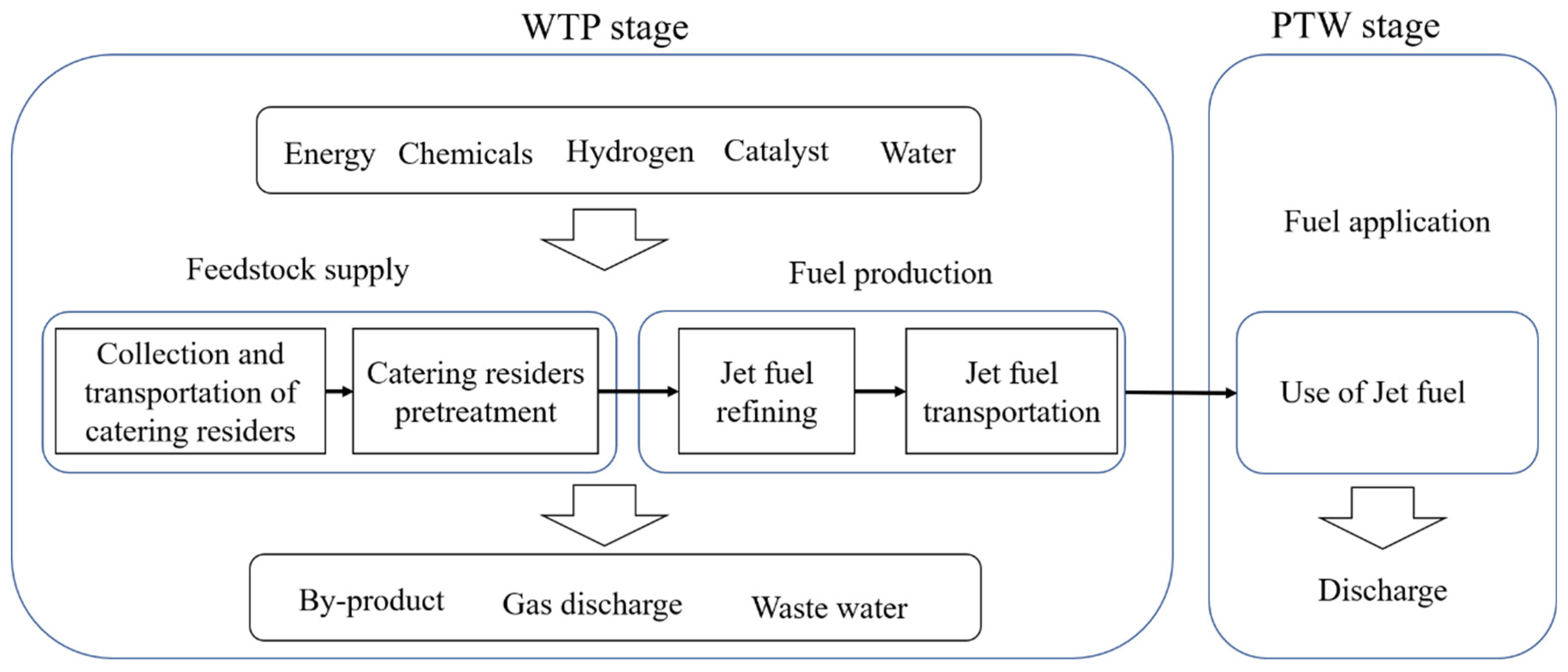
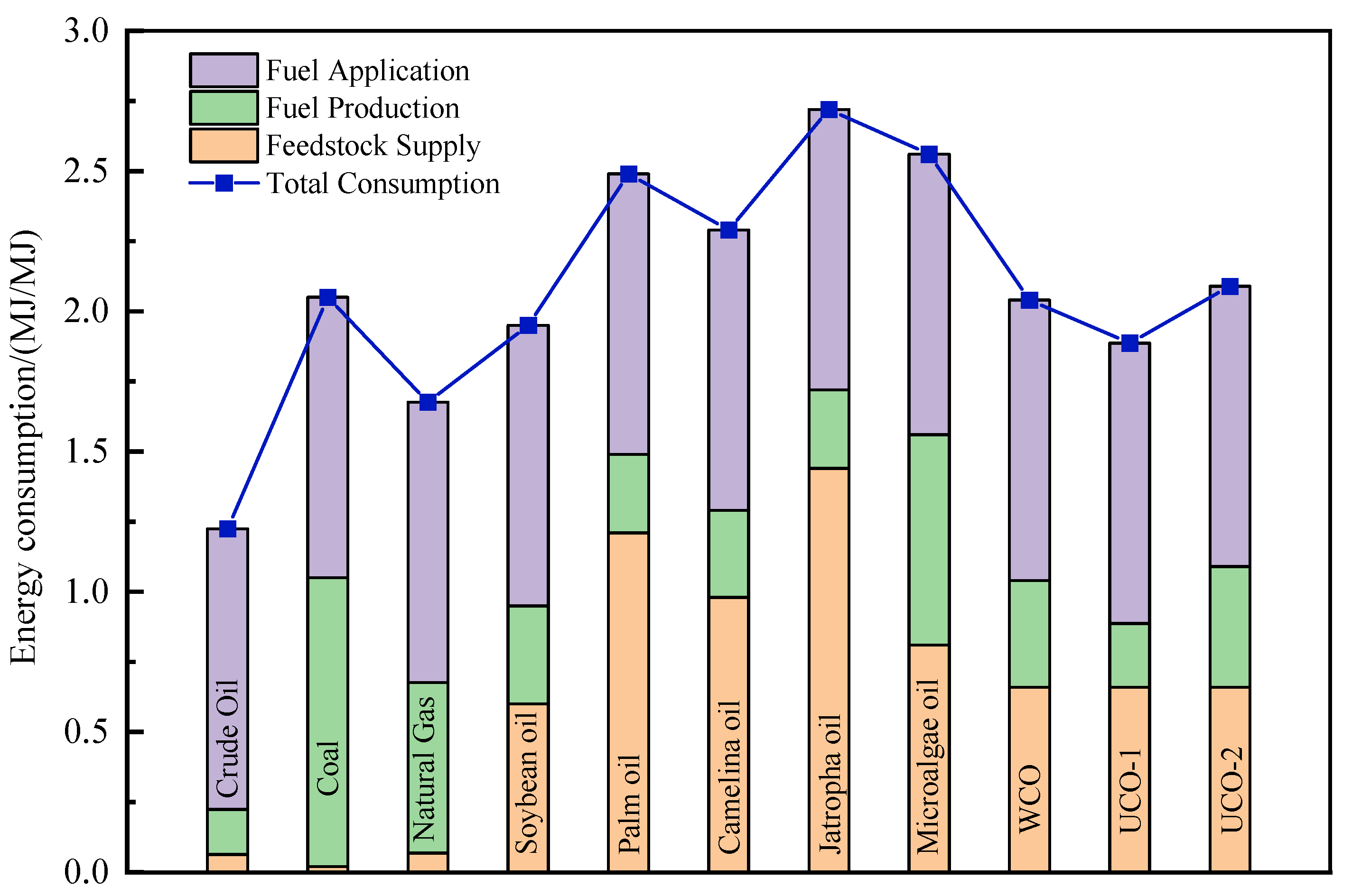

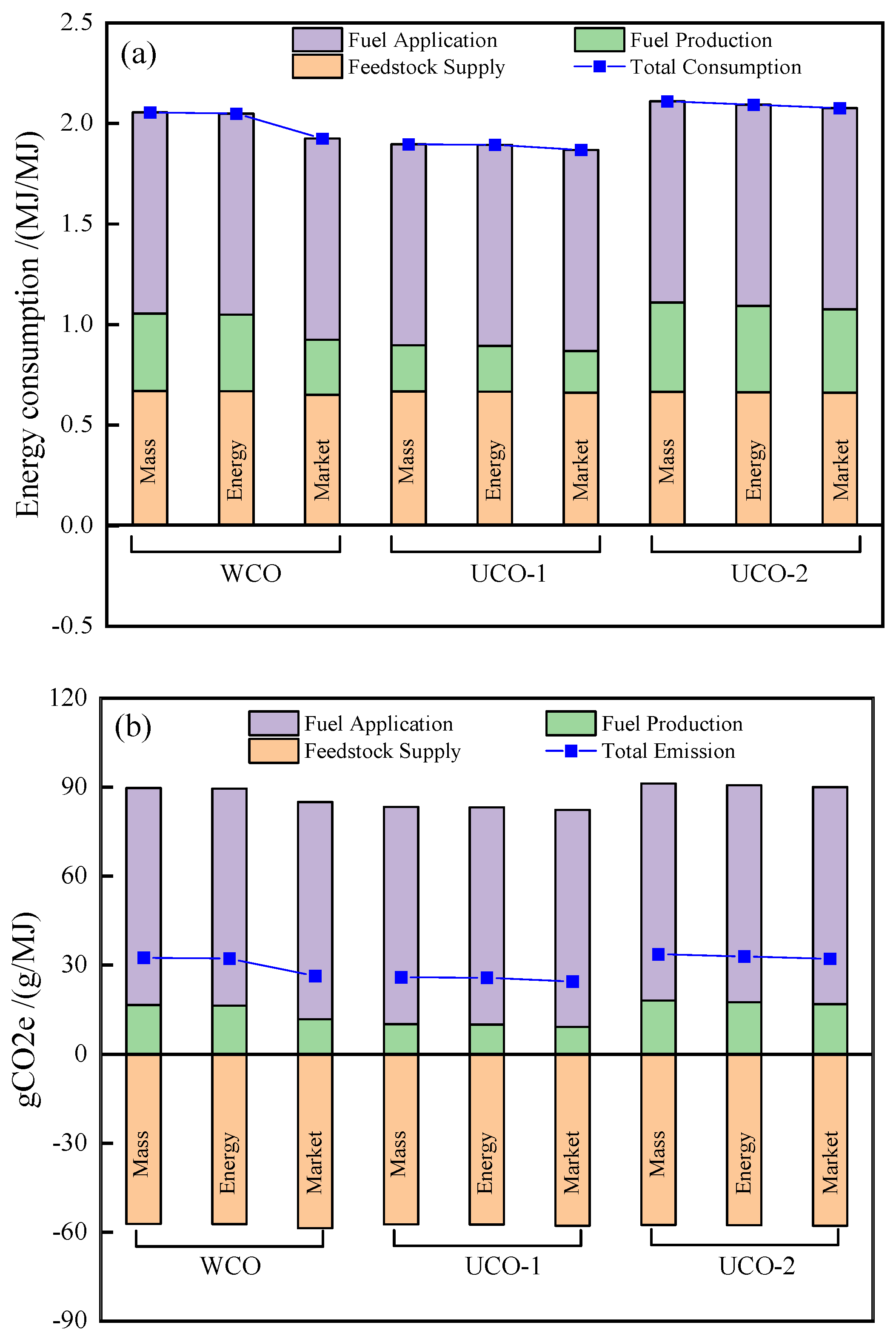
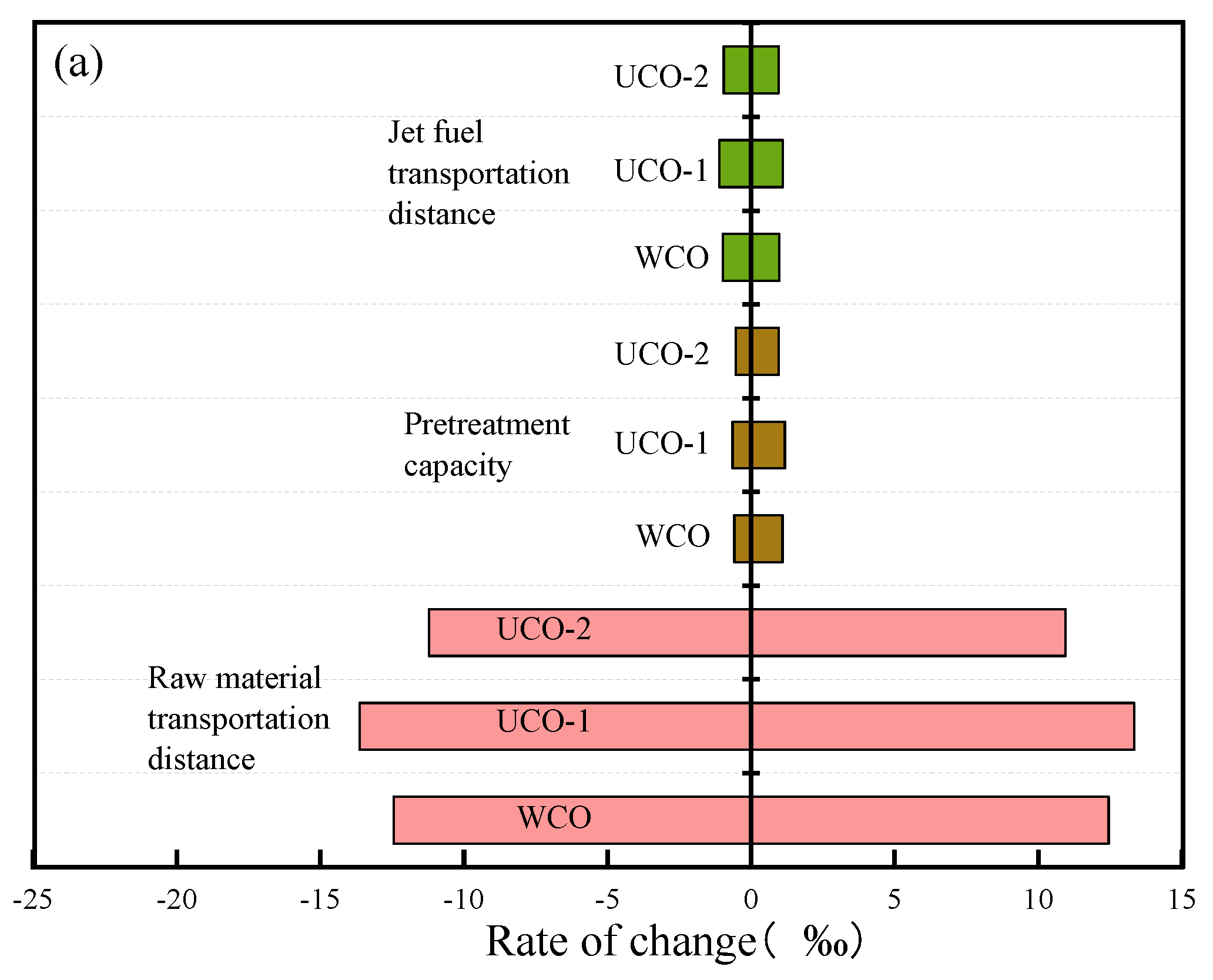
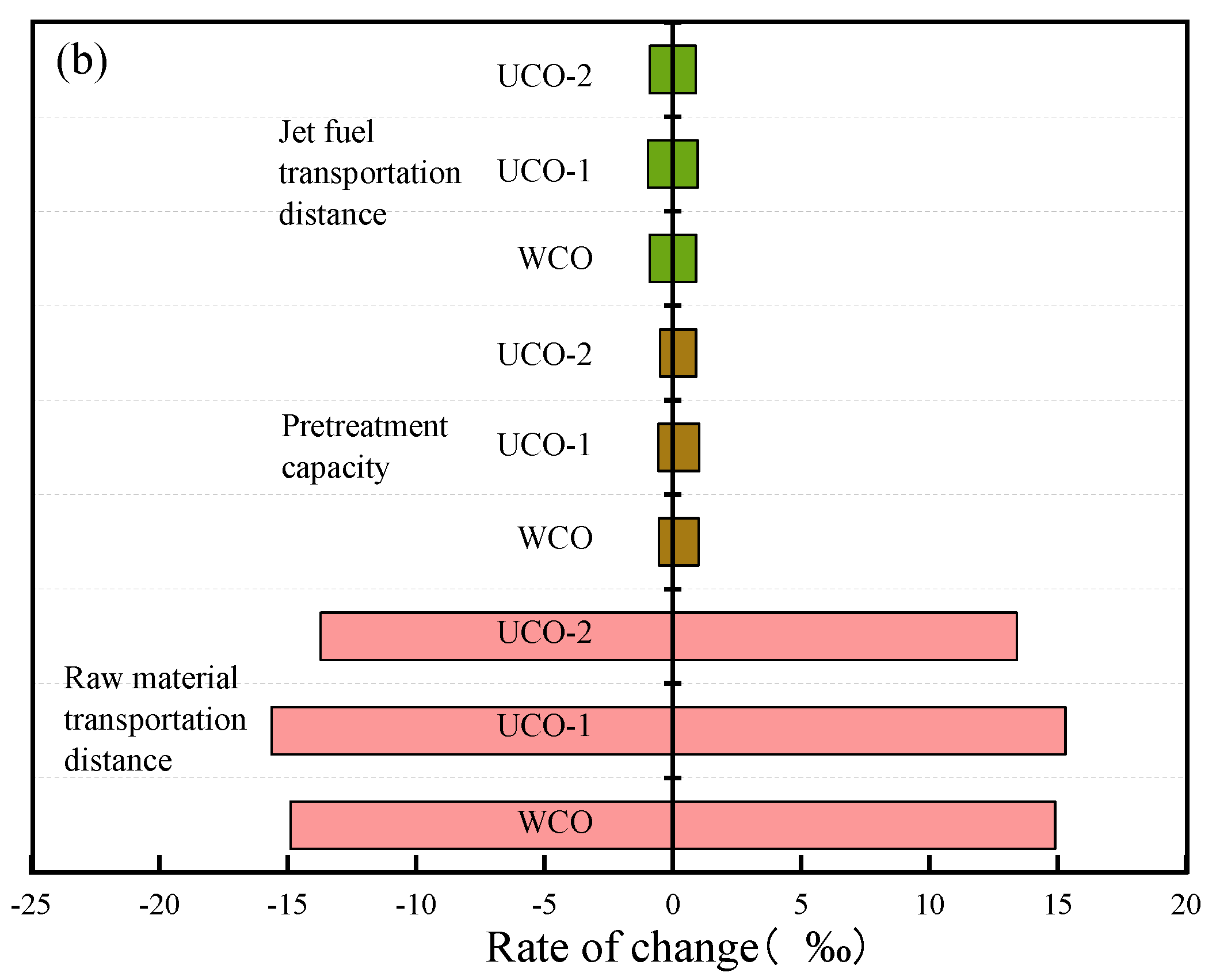
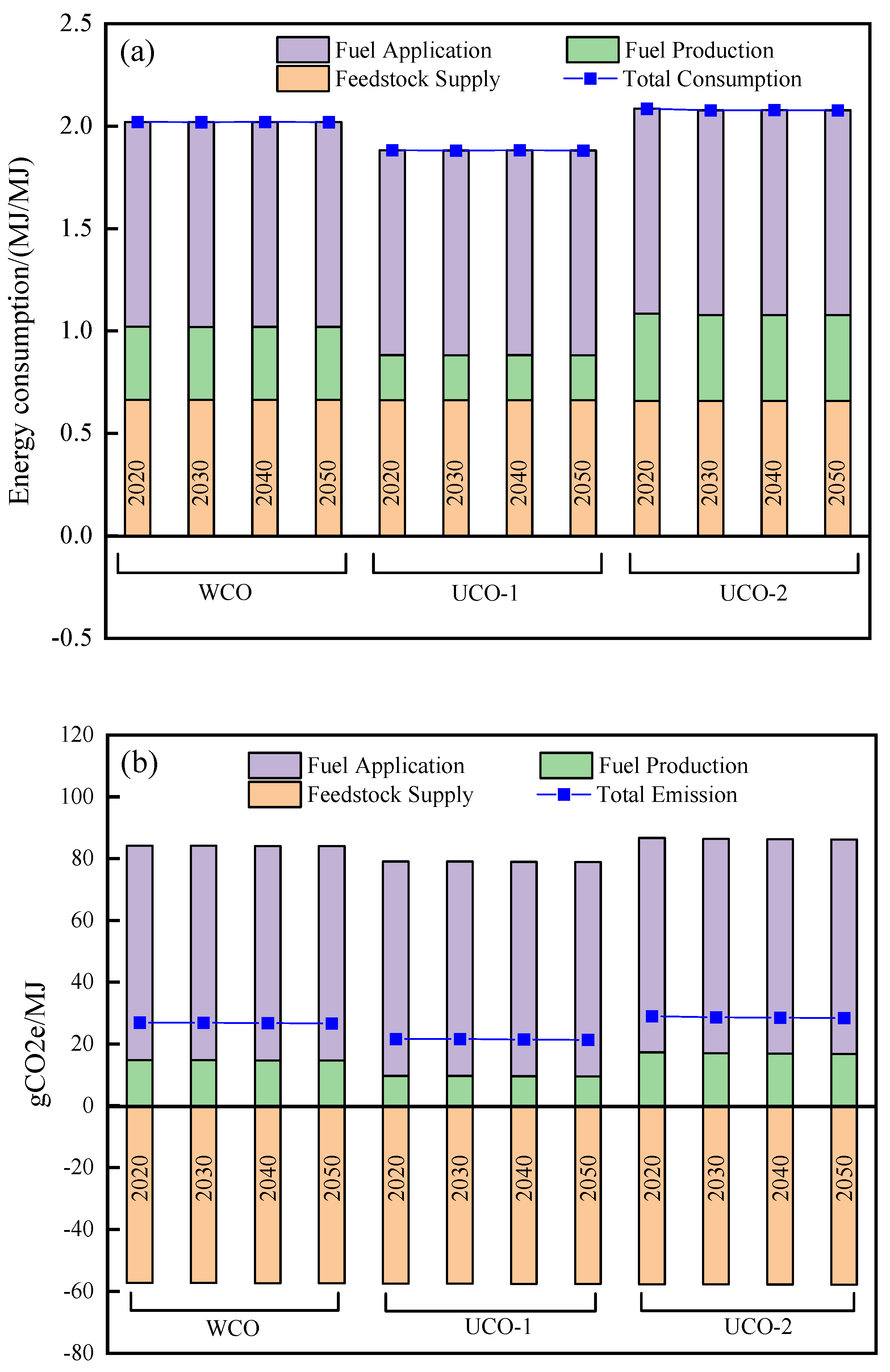
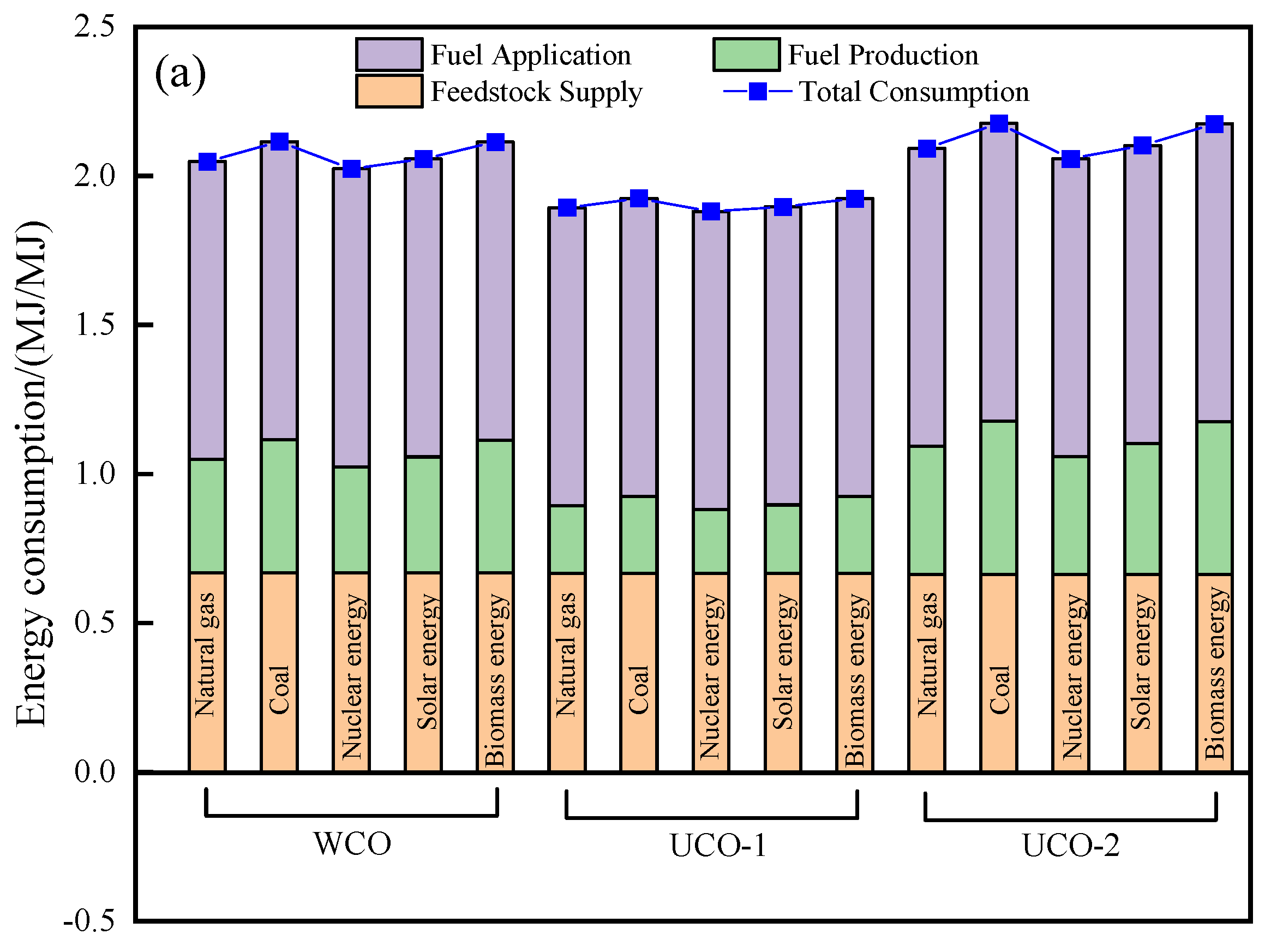

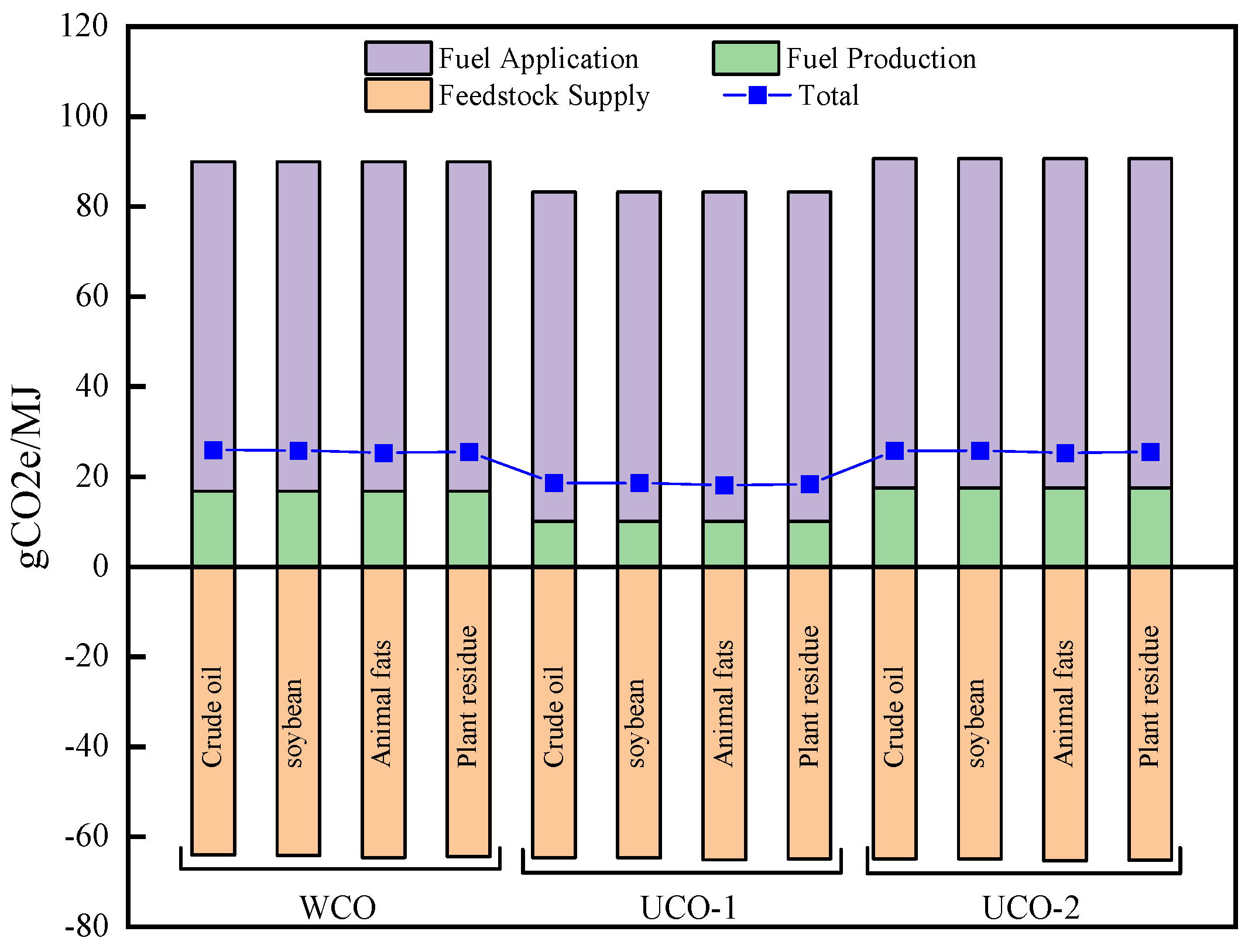
| Parameter | Baseline | Low | High |
|---|---|---|---|
| Raw material transportation distance (km) | 80 | 56 | 104 |
| Jet fuel transport distance (km) | 200 | 140 | 260 |
| WCO pretreatment capacity (m3/h) | 60 | 42 | 78 |
| 2020 | 2030 | 2040 | 2050 | |
|---|---|---|---|---|
| Crude oil | 0.2 | 0.1 | 0.1 | 0.1 |
| Coal | 70.1 | 44.7 | 35.0 | 27.0 |
| Natural gas | 2.5 | 7.6 | 24.0 | 24.3 |
| Nuclear energy | 2.9 | 7.5 | 14.0 | 14.5 |
| Biomass | 0.9 | 2.0 | 5.0 | 10.0 |
| Waterpower | 19.3 | 16.1 | 20.0 | 18.3 |
| Others | 4.1 | 22.0 | 1.9 | 5.9 |
| Hydrogen Source | Energy Consumption/(MJ/MJ) | GHG Emission/(g/MJ) |
|---|---|---|
| Natural gas | 1.6 | 95.7 |
| Coal | 2.3 | 197.6 |
| Nuclear energy | 1.3 | 21.0 |
| Solar energy | 1.7 | 19.0 |
| Biomass energy | 2.3 | 13.1 |
Publisher’s Note: MDPI stays neutral with regard to jurisdictional claims in published maps and institutional affiliations. |
© 2022 by the authors. Licensee MDPI, Basel, Switzerland. This article is an open access article distributed under the terms and conditions of the Creative Commons Attribution (CC BY) license (https://creativecommons.org/licenses/by/4.0/).
Share and Cite
Zhang, Z.; Wei, K.; Li, J.; Wang, Z. Life-Cycle Assessment of Bio-Jet Fuel Production from Waste Cooking Oil via Hydroconversion. Energies 2022, 15, 6612. https://doi.org/10.3390/en15186612
Zhang Z, Wei K, Li J, Wang Z. Life-Cycle Assessment of Bio-Jet Fuel Production from Waste Cooking Oil via Hydroconversion. Energies. 2022; 15(18):6612. https://doi.org/10.3390/en15186612
Chicago/Turabian StyleZhang, Zongwei, Keheng Wei, Junqi Li, and Zihan Wang. 2022. "Life-Cycle Assessment of Bio-Jet Fuel Production from Waste Cooking Oil via Hydroconversion" Energies 15, no. 18: 6612. https://doi.org/10.3390/en15186612
APA StyleZhang, Z., Wei, K., Li, J., & Wang, Z. (2022). Life-Cycle Assessment of Bio-Jet Fuel Production from Waste Cooking Oil via Hydroconversion. Energies, 15(18), 6612. https://doi.org/10.3390/en15186612






